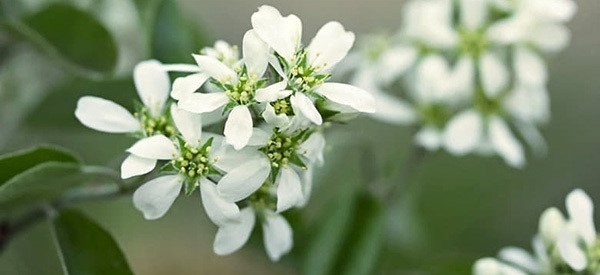
Saskatoon
Saskatoon, (Amelanchier alnifolia) has many names. Famously, the berry is responsible for naming the beautiful prairie city of Saskatoon in the Canadian province of Saskatchewan. It is also known as serviceberry, Juneberry, shadbush, Pacific serviceberry, and chuckley pear among many others. An original, possibly less romantic name for saskatoon berry is pigeon berry.
Of the more than 30 Amelanchier species native to North America, Amelanchier alnifolia is often the front runner when it comes to berry flavor, size, and healthful constituents. Of the many species, some of the others are preferred for their large, long-lasting blossoms, while others have gorgeous, red-tinged foliage during bloom time for dramatic effect. Variation in the species is subtle with similar flowering, leaves, and fall color. Some species have a tree-like form while others may grow to just small shrubs.
Amelanchier alnifolia is native to North America from Alaska, through most of western Canada, and down the northwestern portions of the USA. Important to wildlife, this pretty, fruiting shrub is a common forest understory plant. Plenty of wild ungulates and foraging livestock browse its leaf and twigs. It also provides, food and shelter for a myriad of smaller mammals. The berries, prized by many kinds of birds, may be gobbled up in a single afternoon. Not surprisingly, they are a favorite of black bears, yet, strangely, in some years, the bears and birds will leave the berries alone completely. This may be due to some cyclic infestation as Saskatoons are prone to different kinds of rusts, fungi, and insect pests.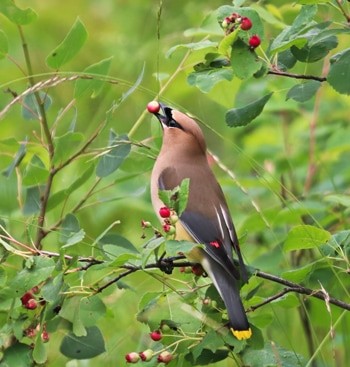
This was the case in my area last year. The little berries just shriveled up on the branches. Perhaps the plants were saving up. This year, the berries have been large, fragrant, and juicy. The weather cooperated with lots of deep rains followed by record high temperatures. Saskatoon berries are perfect for juice, jam, jelly, pies, and syrup. We’ll be making saskatoon syrup and showing the step-by-step method below. Some folks say they can be dried to use as raisins for baking or trial mix. Dried fruits may be best used as tea. This is because they have large seeds, as they are actually a pome-like fruit rather than a berry. Blending the fruit and sifting out the large seeds seems to be a more reasonable way to use this deliciously flavored wild fruit.
Profound respect for saskatoon berry is on the rise. This is due to evidence that saskatoons contain high-levels of polyphenols which contribute to observed anti-inflammatory, anti-diabetic, and chemo-protective effects. More than just a sweet, lovely tasting wild food, saskatoon may be a favored alternative medical food for treatment and prevention of illnesses such as diabetes and cancer in the future.
The History of Saskatoon
The name Saskatoon replicates the original name the North American indigenous people, the Cree, called these useful, healthful berries. As mentioned above, the city of Saskatoon, Saskatchewan in Canada is also named in honor of this plant. On a more morbid tangent, the name serviceberry comes from the early blooms of this shrub signaling to the pioneers and early settlers that the ground had thawed enough to dig graves for the winter’s deceased, thus it was an opportune time to service the dead.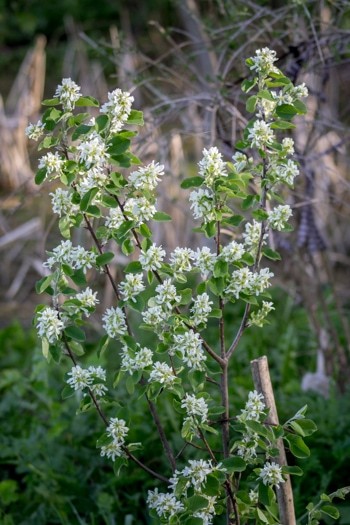
Through North American history immemorial, saskatoon berries have been used as food by people and animals. The sweet tart fruit was used fresh or dried. As a flavoring, it was useful to season soup or meat. Saskatoon, were dried and used in making pemmican. A tea was made by the Blackfoot Indigenous people that was used to treat diabetes and promote overall health. It was made not only from berries, but twigs and leaves were also used.
Amelanchier alnifolia has strong wood that was used by indigenous people to make drying racks, rigging for fishing, wood for arrows, and as digging tools.
For untold generations, Amelanchier alnifolia has been a valuable plant for wildlife and is an important part of the ecosystem. It provides food and shelter for many rodents and songbirds. It is browsed by moose, deer, and elk. In addition to the fruit, the twigs, leaves, and bark are eaten by many animals including beaver, rabbits, marmots, and bears.
Where Saskatoon Berry is Found
The Amelanchier alnifolia species, known as saskatoon berry, is a North American native plant. It can be found throughout Alaska and most of Canada. It is found as far south as California and into the east in Colorado, Nebraska, and Iowa.
Often growing in the forest understory, Saskatoon berries may grow at sea level all the way up to 11, 000 ft in the Rocky Mountains. A resilient shrub, it may grow in moist wetlands but also performs in dry, open woods and hillsides. It tolerates sun, part shade, and shade in well-draining soils.
As a durable, adaptable fruiting shrub, Saskatoon species are grown for commercial fruit production and some cultivars produce larger fruit, up to ½ an inch in diameter.
Related: The Complete Map of Edible Plants: Find Out What You Have in Your Area! (Video)
How to Identify Saskatoon
- Shape: Clump and colony forming, the shrubs are upright and erect. Some may grow as a single-trunk tree, but most will have upright open branching. This shrub grows 3 to 18 feet but possibly larger in rich soil environments.
- Leaves: alnifolia leaves are oval with a pointed tip. The margins are toothed particularly towards the tips.

- They are simple and are arranged alternately on the stems.
- The 1 to 2 inch pale green leaves turn yellow to orangey red in color in fall.
- Flower: Flowers are ¾ to 1 ¼ inches across with 5 long white petals. Flowers appear in early spring, April, May, or June, just as leaves are unfolding, often earlier than most spring-blooming shrubs.
- Stem: Stems are upward branching and have a firm grey bark.
- Fruit & Seeds: The fruit is a ¼ to ½ inch, blue to purple pome found on branch tips and in clusters. The seeds are small, hard, and dark brown.
Related: Plant Identification Guide – 400 Wild Plants That You Can Forage For (Video)
How to Grow Saskatoon
A lovely plant in the landscape, saskatoon are very tough resilient shrubs. It is excellent to know the species you are after as many Amelanchier can grow quite large, while others stay very small. Check the labels at the garden center to see what variety it is and how large it may grow to avoid being surprised.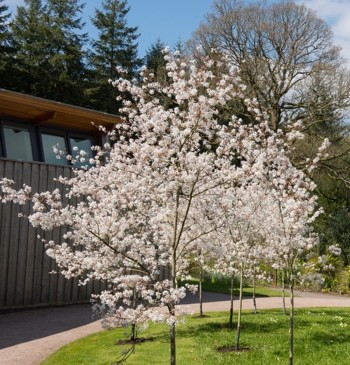
Amelanchier alnifolia can also be propagated by seed or by rooting hardwood or softwood cuttings.
This wonderful plant tolerates many soil conditions, sun and shade exposure, and moisture levels. I can only imagine fruit is much more prolific, large, and sweet in moist, full sun locations. This seems to be true in the wild, at least. They are not the longest living forest shrub with a lifespan of around 20 years. In optimal conditions, there are specimens that have survived to 85.
Related: 10 Plants That You Should Never Plant Together (Video)
How to Harvest Saskatoon Berries
On a good season, you may be trying to get ahead of the animals and birds. Saskatoons are often ready to pick in July, although ripening may be influenced by elevation and weather.
Beautifully ripe berries are ready to pick when they are blue to dark purple in color, are firm but not too hard. They are usually not all ripe at once, but a couple of pickings will usually catch most of them.
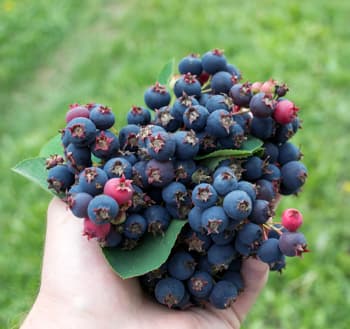
Since we humans aren’t the only ones who like this yummy treat, pick with some thoughtfulness of other animals and birds that may by relying on them. After all, they don’t have a grocery store to run to. Great places to pick from may be areas close to a road that might not be great for wild animals anyway.
As saskatoons are often used in commercial landscaping, there may be some opportunities to pick in urban areas. Of course, these areas are often food deserts for wild animals that have adapted to human urban settings. It is kind to be considerate of that and only pick a bit from each area.
When choosing a place to harvest from, try to find a place that is free from pesticides and herbicides, if possible. There are u-pick saskatoon berry operations that are usually open in July. Interestingly, although we had a good season out here in the mountains, I was just noticing a u-pick in the actual City of Saskatoon, did not have a good year. As with all fruits, the harvest is always reliant on the weather.
What Saskatoon Is Good For and The Natural Remedies Made From It
Saskatoon berries are extremely nutritious. They are high in compounds that act as an anti-inflammatory and antioxidant. Interestingly, there is ongoing research resulting in saskatoon berry having beneficial effects on health concerns related to diabetes and cancer. They are similar in beneficial compounds to other berries and small fruits. Incredibly, some healthful components in saskatoons are even higher than in blueberries.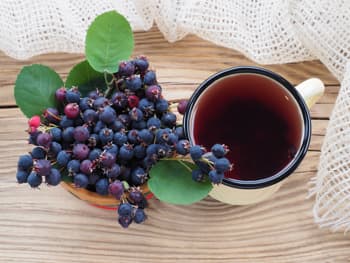
The healthful compounds are also present in the leaves and twigs. This may be why some people indigenous to North America used Saskatoon berries as well as twigs and leaves to make a tea to aid in overall health and to help treat symptoms related to diabetes.
Saskatoon berries make an excellent supplement to the diet. They have high levels of vitamins and minerals. Importantly, they are rich in manganese, iron, potassium, as well as B vitamins and vitamin A and C.
Related: Add This “Unusual Nutrient” to Coffee or Tea, to Effortlessly and Fully Empty Your Bowels Every Single Morning (Learn More)
What Parts of Saskatoon Are Used In Remedies?
Studies show that the saskatoon berry, leaves, roots, and stems contain high levels of healthful compounds. These studies show saskatoons have high levels of flavonoids which are known to have many protective and health-promoting effects.
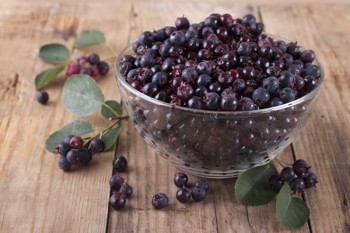 This means that including saskatoon in the diet may have preventative and therapeutic effects on issues such as inflammation, cardiovascular disease, neurodegenerative issues, obesity, diabetes, and cancer. This is because these compounds work as antioxidants, anti-inflammatories, antidiabetics while being neuroprotective and vessel protective.
This means that including saskatoon in the diet may have preventative and therapeutic effects on issues such as inflammation, cardiovascular disease, neurodegenerative issues, obesity, diabetes, and cancer. This is because these compounds work as antioxidants, anti-inflammatories, antidiabetics while being neuroprotective and vessel protective.
The antioxidant effects of Saskatoon berries show potential in providing a protective role against issues with chronic inflammation. Inflammation is often associated with cardiovascular disease. The anthocyanins, some of the flavonoids in Saskatoons, are thought to help disrupt the progression of cardiovascular disease.
Other bioactive components, especially polyphenols, found in Saskatoons help to reduce blood glucose and regulate glycogen accumulation, making Saskatoons a heavy contender in the fight against diabetes.
Related: Similar to Morphine: The Best Natural Painkiller that Grows in Your Backyard (Video)
A DIY Saskatoon Syrup Recipe
Saskatoon syrup is a delicious way to celebrate this healthful, yummy wild fruit. This recipe is using heat which may be detrimental to some of the super healthy compounds within saskatoons. Alternatively, cold-pressed juice, fresh flash freezing the berries, or drying the berries may protect the bioactive compounds in this incredibly beneficial fruit.
Method
Simply, we will be boiling together, 1 cup of berries, ½ cup of water, 1/3 cup of organic cane sugar. This is then mashed together and strained, for a delicious, sweet, fruit-laden dessert syrup.
Step 1: Find and identify Amelanchier alnifolia and mark it for future harvests. Finding plants in areas where herbicides and pesticides are never used is wonderful, as those chemicals may have adverse effects on health. There may be a farm or u-pick operation in your area which is always a wonderful choice.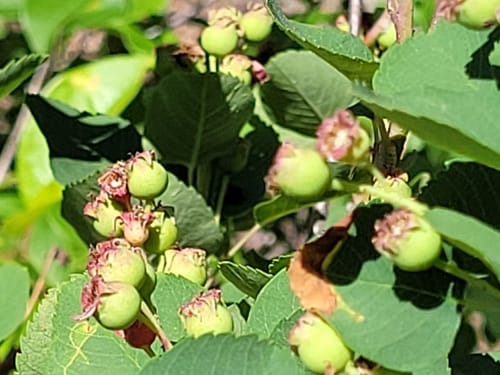
Step 2: Keep an eye on the plants to see when the berries are ripe. If you are harvesting from the wild, be sure to harvest only 20% to 30% of the crop you find, leaving the lion’s share for the wild birds and animals. I assure you; they need them more than you do.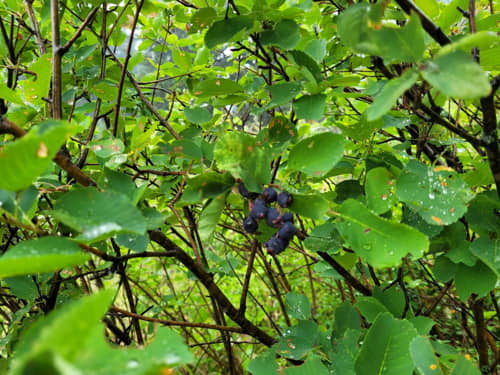
Step 3: Bring your harvest home or to wherever you want to process them. Pick over and rinse the berries, removing any stems or less-than-perfect berries. This is my late season harvest. A little meek, I will be the first to admit. The berries are a little dried, on the raisin side, but are fine for my purpose here.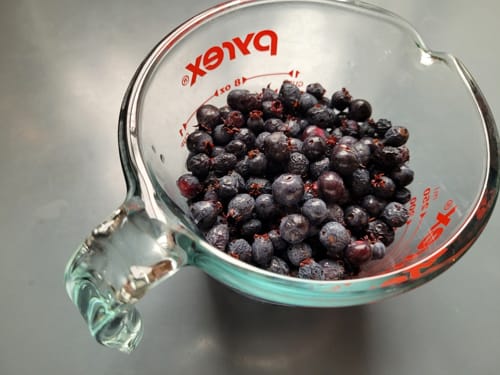
Step 4: Combine 1 cup of berries, ½ cup of water, 1/3 cup of organic cane sugar in a small pot. Bring to a gentle rolling boil for 10 to 15 minutes. For extra sweetness, add a spoonful of honey or maple syrup. This is best done in the cooling down phase once the combination is less than 60° F to preserve the healthy enzymes and compounds in these sweeteners.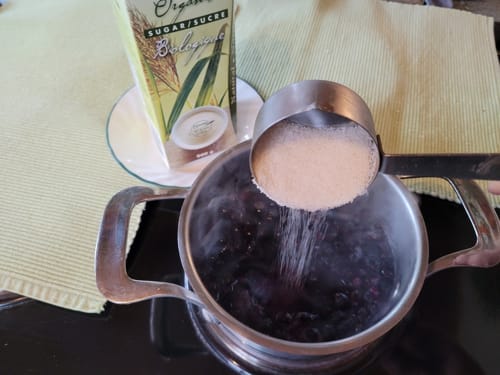
Step 5: Press the syrup through a sieve to remove seeds and skins.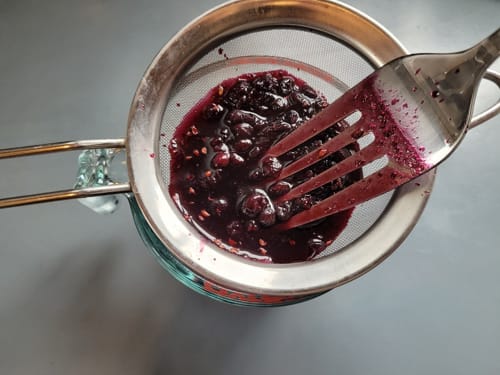
Step 6: Serve the warm syrup on your next delicious treat. It is an incredible syrup for ice cream or pancakes. The leftovers can be placed in a jar for future use. This syrup will last in the fridge for 2 to 3 weeks.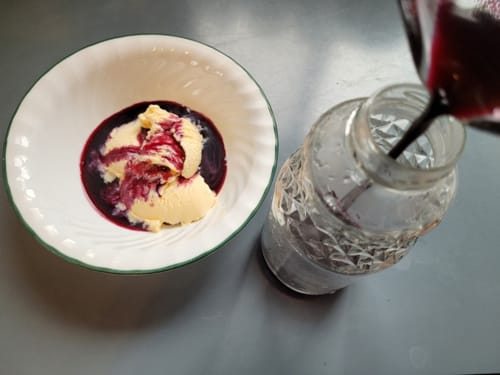
Potential Uses
Saskatoon berry syrup can be used as any delicious fruit syrup. The gorgeous purple color might be added to baked goods or icing. I am just using a tablespoon or so in my morning smoothy for a sweet little addition of those dark purple polyphenols.
Related: 1 Cup Before Bed Shrinks Belly Fat All Night (Video)
Dosage
Determining a dosage for saskatoon may depend on the reason for consuming this healthful plant. More research is needed to define the proper dosages of saskatoon berry for common chronic diseases.
From a nutritional supplement point of view, just 1 cup of saskatoon berries provides 1/5 of daily calcium, between 25% – 75% of daily fiber, ¼ of daily magnesium, and 50% of daily vitamin E. It is a super fruit packed with phenolics, anthocyanins, and has 2 times more fiber, potassium, iron, and 4 times more magnesium than blueberries.
How To Preserve Saskatoon Berries
From a food as medicine perspective, the best possible ways to preserve this healthful super fruit would be by cold-pressed juice, fresh flash-frozen, or drying the berries.
For drying, it may be best to macerate the fruit and pass through a sieve to remove the seeds. Once the seeds are removed, the remaining pulp will make incredible fruit leather either on its own or combined with other fruits.
Although it is possible that some of the healthful compounds may be sensitive to heat, saskatoons make delicious jams, jellies, pie filling, juice, and syrup. They are also incredible additions to your favorite homemade fruit preserves and combine beautifully with cherries, peaches, apples, and rhubarb along with all your favorite berries.
What Plants Resemble Saskatoon?
| Feature | Saskatoon berry, Amelanchier alnifolia | Lowbush Blueberry, Vaccinium angustifolium | Snowberry, Symphoricarpos albus |
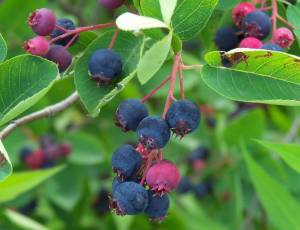 |
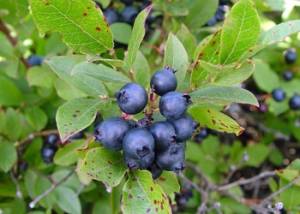 |
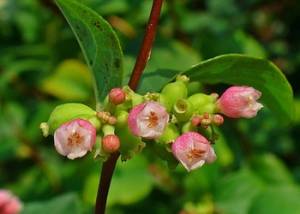 | |
| Size | 3 to 18 feet | ½ to 2 feet | 3 to 6 feet |
| Leaves | 1-to-2-inch oval leaves serrated at tips, alternate on stems. | ¾ to 1 ½ inch elliptical leaves are smooth, medium green, have finely serrated margins and appear alternate on stems. | Leaves are dull green up to 2 inches longand oblong to rounded in shape. |
| Flowers | Flowers are ¾ to 1 ¼ inches across with 5 long white petals, blooming in early spring, April, May, or June. | Small clusters of ¼ inch nodding tubular flowers grow from last year’s stems blooming in spring to early summer. | Tiny pink bell-like flowers are 3/16 of an inch long and bloom at the leaf axils in summer. |
| Fruit and Seeds | The fruit is a ¼ to ½ inch, blue to purple pome found on branch tips and in clusters. The seeds are small, hard, and dark brown. | The fruit is 1/3 of an inch across, dusty blue when ripe. The flesh is juicy, sweet and contains 10 to 15 seeds. | Fruit is ½ inch green fruit which turns white at maturity and persists through winter. |
| Bark | Firm grey bark. | Young wood is reddish brown, while mature wood has hard bark that is shredded in appearance. | Twigs are slender with grey bark. |
Warnings And Cautions
The saskatoon berries, particularly the seeds, contain cyanogenic glycosides which may become cyanide. Many edible foods contain this compound including apples, plums, peaches, spinach, and barley. Removing the seeds when utilizing large amounts of saskatoon may be a good idea.
When trying new foods, consider trying small amounts or consuming in moderation in case of any sensitivities.
Always check with your healthcare provider before starting new herbal remedies.
You may also like:
How to Use Mulberry Medicinally
Herbal Focus: Blue Elderberry (Learn More)
How To Make Your Own Raspberry Vinegar
10 Berries You Should Look For In The Woods
DIY Colon Detox with Ingredients You Have in Your Kitchen Right Now






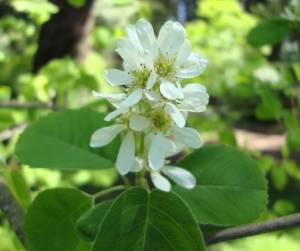
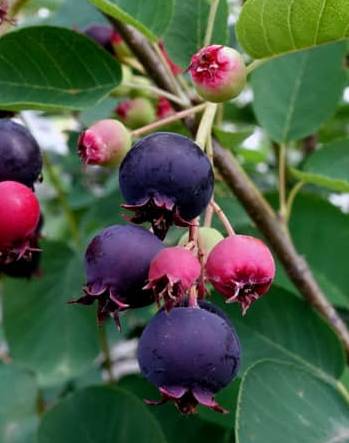
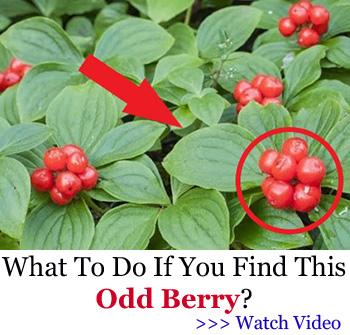
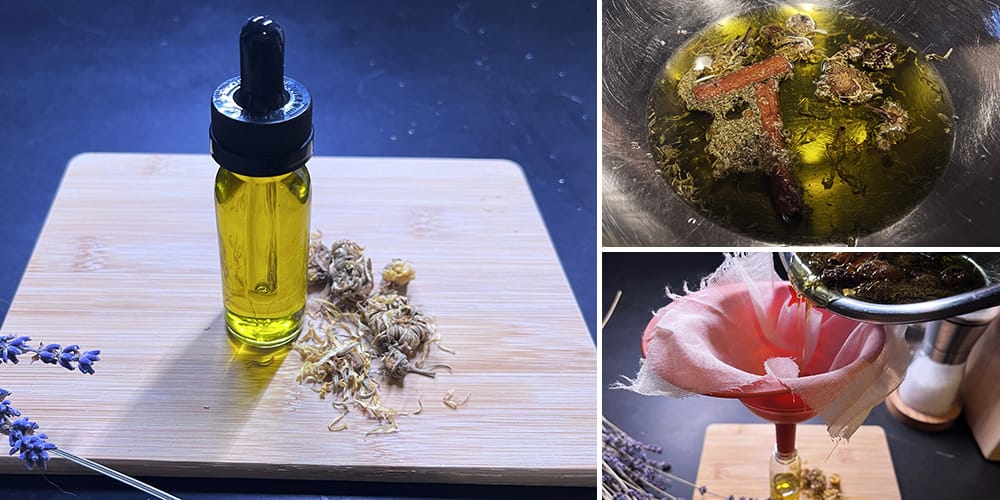
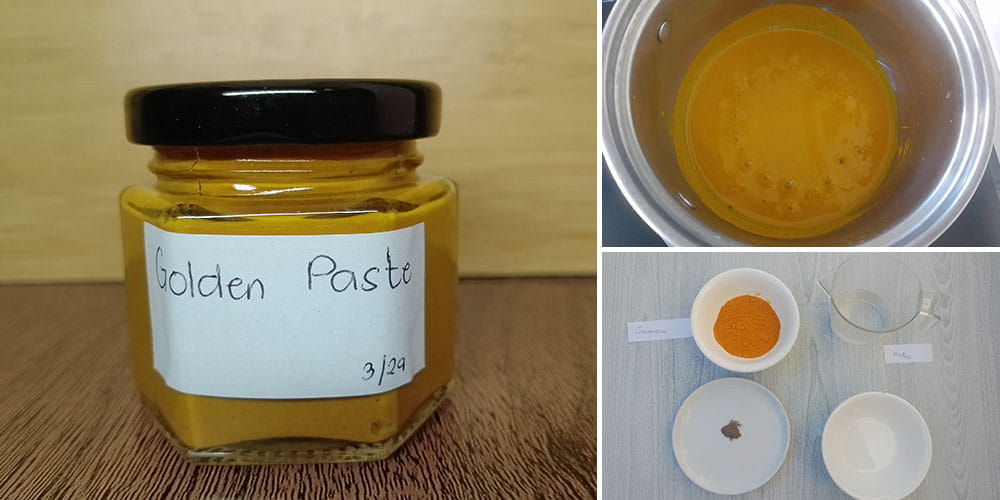
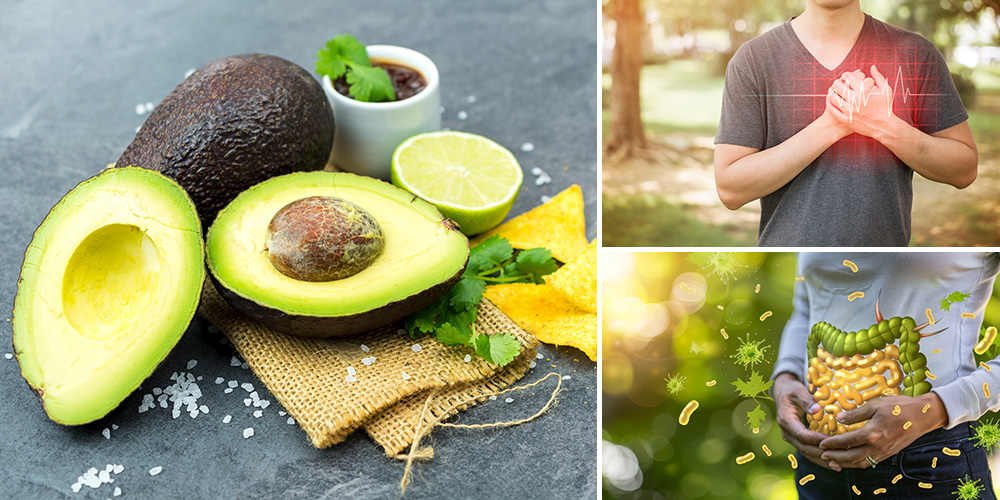
this is great information thank you! where can I
get a plant?
Where can I purchase this planet
I’d say, put the fresh berries in ACV. Leave for any amount of time., a few days to a couple weeks. Strain the berries and press the seeds out and put in a jar with raw honey just to cover.
Now you have a lovely raw syrup or jam for countless things and very nutritious ACV.
Using the berry infused vinegar in drinking water or added to a dish of water for a sponge bath.
Can these plants survive in the harsh climate of central Nevada? I live above 4300 feet in elevation with long hot (+100 ) degree days and lows(20 ) .
I really appreciate the knowledge you share with me!
Well, Claud, my grandfather left county Dobra Ukraine around 1900 his name was John Dobriansky. He said it was the Bolsheviks. He did not like talking about it. His wife cooked a lot of squab, goose, pheseant & duck. It was EXCELENT!